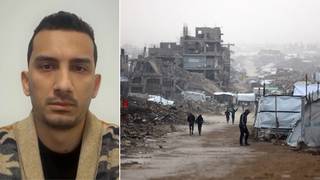
Guests
- Meron Rapoporteditor and writer at the independent Israeli news site Local Call and columnist at +972 Magazine.
The independent news outlets +972 Magazine and Local Call are reporting that Israel is increasingly using grenade-firing drones to enforce evacuation orders. Israeli soldiers have admitted that they deliberately target civilians and likened their use of the weapons to a “video game.” Israeli journalist Meron Rapoport explains how soldiers are instructed to initiate strikes on all residents, not just belligerent targets. “Once a commander defines an imaginary red line that no one is allowed to cross, anyone who does is marked for death,” says Rapoport.
Transcript
AMY GOODMAN: This is Democracy Now!, democracynow.org, The War and Peace Report. I’m Amy Goodman.
The independent news outlets 972 Magazine and Local Call, run by Palestinian and Israeli journalists, have revealed Israel is increasingly using grenade-firing drones to enforce evacuation orders. Israeli soldiers admitted to 972 they deliberately targeted civilians so others will, quote, “learn not to return to their homes.” One soldier said using drones to target Palestinians was, quote, “like a video game.”
For more, we go to Tel Aviv, where we’re joined by Meron Rapoport, editor and writer at the independent Israeli news site Local Call, a columnist at 972 Magazine, which published the new report headlined, “'Like a video game': Israel enforcing Gaza evacuations with grenade-firing drones.” The piece has already elicited a response from the Chinese firm Autel, which says it never knowingly sold and authorized its drones for use by Israel’s army. 972 Magazine's new piece is headlined, “Autel denies selling drones to Israel. So why are they roaming Gaza's skies?”
Meron Rapoport, welcome back to Democracy Now! Lay out what your report reveals.
MERON RAPOPORT: The report reveals that from the beginning of the war, Israeli soldiers started to use very simple, cheap drones that were bought independently at the beginning, even by donation, by — from Amazon or whatever, and eventually the army turned these drones, that are basically for photographing, for surveillance — they turned them into attacking machines by adding some kind of tool that enables these drones to throw grenades from the air and using a remote control in order to throw them in Gaza. This is quite widespread. It exists in almost all the combating units in Gaza, as far as we know. As it was not by the beginning — at the beginning, distributed by the army itself, but bought by the soldiers themselves, by the units, it’s less organized, but still, it’s quite, quite widespread.
AMY GOODMAN: So, +972 and Local Call spoke to seven Israeli soldiers and officers who served in Gaza, for the investigation. A soldier they identify as “S.” was deployed in the Rafah area for nearly a hundred days, where his battalion conducted dozens of drone strikes. S. said the intention of the strikes was to kill, despite the majority of victims being located at a distance where they couldn’t have been a threat to soldiers. He said, quote, “It was clear that they were trying to return to their homes — there’s no question. … None of them were armed, and nothing was ever found near their bodies. We never fired warning shots. Not at any point,” the soldier said. He went on to describe the aftermath visible in the drone footage, dogs eating the bodies that weren’t collected: quote, “I couldn’t bring myself to watch a dog eating a body, but others around me watched it. The dogs have learned to run toward areas where there’s shooting or explosions — they understand it probably means there’s a body there,” unquote.
Another soldier identified as “H.” who served in central Gaza said, quote, “Were they aimed at armed militants? Definitely not. Once a commander defines an imaginary red line that no one is allowed to cross, anyone who does is marked for death,” unquote.
In your report, you note, quote, “The Palestinian journalist Younis Tirawi published footage he had obtained of one of these drones dropping a grenade, which according to him targeted civilians in the Netzarim Corridor in northern Gaza. On the drone controller screen, the text 'Iron ball drop device' appears. Based on the interface design and additional images reviewed by +972 and Local Call, there is strong evidence that the drone was an Autel model.”
Respond to all of this and the significance of Autel.
MERON RAPOPORT: Yes, I think we have learned from these testimonies — and there were others also published by Yaniv Kubovich in Haaretz a few months ago — that the Israeli army draws some kind of imaginary lines in Gaza where Palestinians are not supposed to cross, and the way they learn that they cannot cross it is by practically shooting them. So, then, the other Palestinians will understand that this is a line that cannot be crossed.
Now, in this, what we have described is connected also to the evacuation orders that grew in numbers and in magnitude in the last few months, in which Israel ordered the Palestinians to leave whole neighborhoods in Rafah, then in Khan Younis, also in the north. And the way these drones were used is to sort of force this evacuation order by targeting those who were found in these areas. Either they didn’t leave yet, or they tried to return to their homes. And using the drones enables the soldiers to target from afar. They don’t need to be quite close to the Palestinians. It could be in two kilometers, three kilometers away, because they’re using drones and, of course, a TV screen that enables them to see what they are targeting.
Now, Autel — and there are other drones, I must say, that are being used, civilian drones that are used in Gaza by other companies, Chinese companies. Autel are saying that they never authorized this, that this is against their policy, completely against their policy, that they are not — that their drones should not be used in combat areas and not target civilians. It is really not very clear how these drones arrived there, but it is quite — but distributors in Israel told us that Autel is more or less aware. We don’t know what’s the truth there. Autel, as I said, denies that completely, categorically, and say that these distributors are not saying the truth. But the fact of the matter is that these drones are there, that they are by Chinese manufacturers, either Autel or others, and that they are used to attack civilians. This is the fact of the matter.
AMY GOODMAN: And finally, talk to us about that quote of an Israeli soldier who talked about the goal is for Palestinians to “learn through blood.”
MERON RAPOPORT: Yes, this, unfortunately, is not new. As I said before, there was also a report by Yaniv Kubovich in Haaretz about four or five months ago, and, again, on the Netzarim Corridor, where he also had the testimonies, quite similar, of soldiers saying that the army draws some line, and the way to implement this line is just to shoot anyone who crosses this line, and many, he said, that are — this report also, that the great, great, great majority of them were just civilians. Now, with the drones, it is more effective, because it could be, as I said, on a wider range, two or three kilometers away from where the soldiers are stationed. But the idea is the same: There is a line, and the line — the Palestinians know where the line is just by being shot at.
AMY GOODMAN: We’re going to have to leave it there. I want to thank you so much, Meron Rapoport, editor and writer at the independent Israeli news site Local Call, columnist at +972 Magazine. We’ll link to the new “report”: “'Like a video game': Israel enforcing Gaza evacuations with grenade-firing drones.” It was written by Yuval Abraham, who is the Oscar-winning co-director of the film No Other Land.
Next up, as the Trump administration shutters the EPA’s research arm, we’ll speak with a former EPA top administrator and with the journalist behind a project featuring federal workers who are speaking out, called I Do Solemnly Swear. Stay with us.
[break]
AMY GOODMAN: “U’Huh” by Sinkane, performed in our Democracy Now! studio.












Media Options